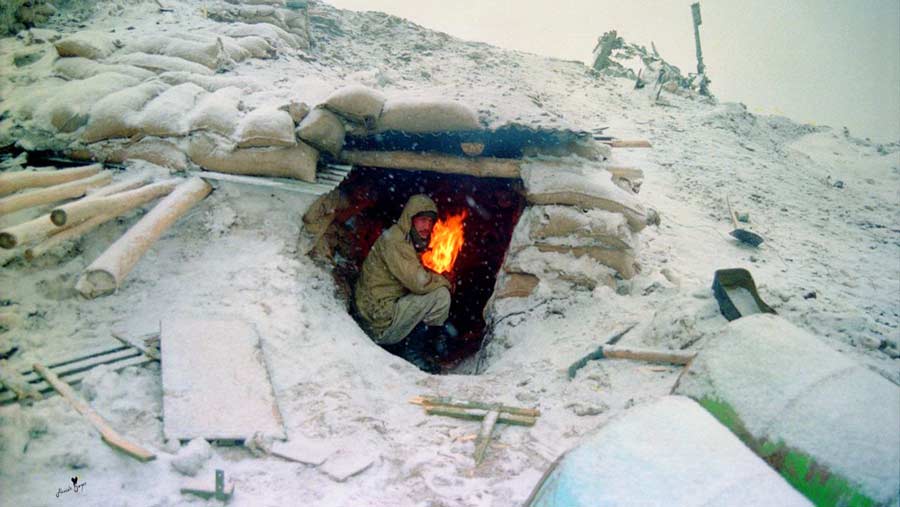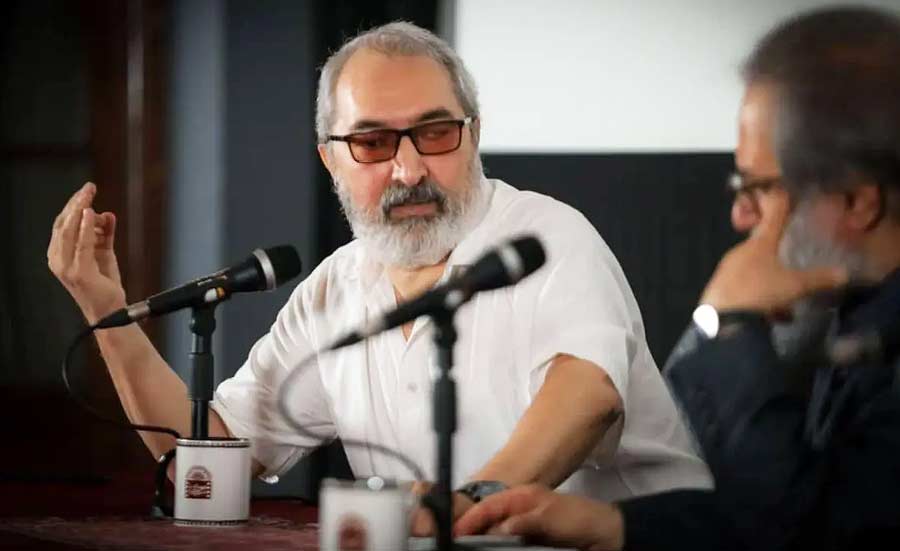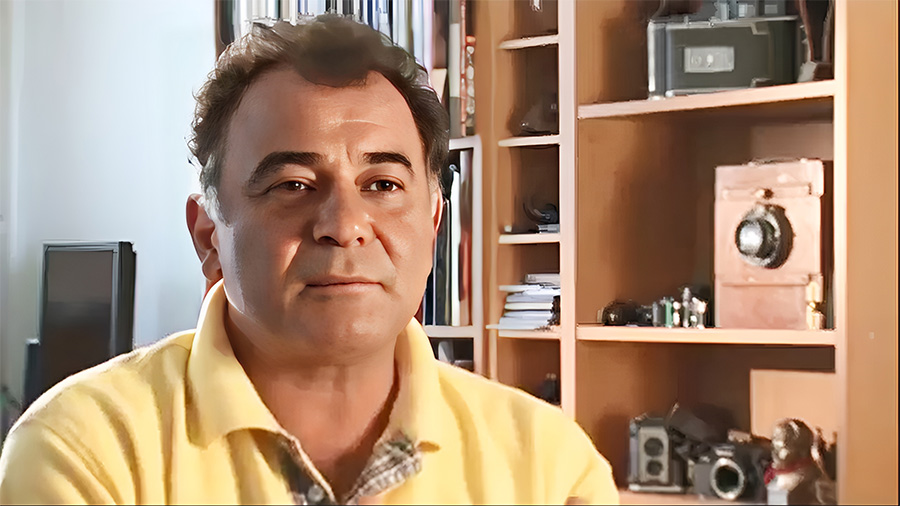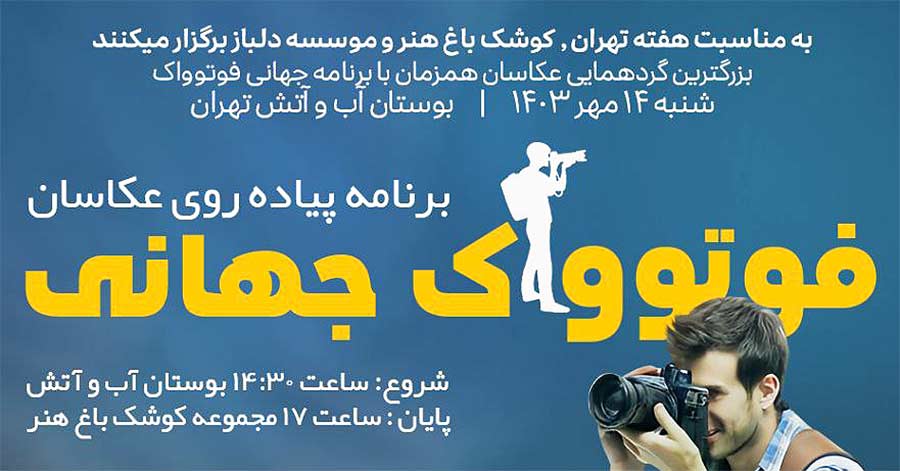Favorite rituals of Iranian photographers in Muharram mourning

The diverse forms of Ashura mourning, which are rooted in the cultural contexts of the tribes, have always been attractive to photographers and documentary makers.
Every year during the month of Muharram and Safar, native mourning rituals are held, which recording has been important for many photographers and documentary makers, and thousands of photos and videos of this great religious community are recorded every year, but ritual photography is not just recording a simple event, but an effort. It is for the thinking and correct understanding of the artist in conveying the concepts and examples of the Ashura culture, which according to its social impact and functions, photographers should have a correct knowledge and awareness of the philosophy of this great historical event before taking photographs. To be able to reflect the symbols and signs of this knowledge and taste of religious art in their works by relying on the knowledge of aesthetics.
Ashura in Abyaneh
Abyaneh is one of the historical villages of Iran with authentic and traditional people who adhere to their traditions. Muharram and its mourning are one of their most important and exciting religious ceremonies.

The people of Abyaneh, even if they have migrated and gone to other cities, bring themselves to Abyaneh for Hossein’s mourning; So that on the two days of Tasu’a and Ashura, about four thousand people mourn the martyrdom of Aba Abda Al-Hussein (AS) in Abyaneh.
The interesting thing to note in this village is the clothing of Abyaneh men and women who keep it under any condition, even during mourning, Muharram, etc.
The people of Abyaneh, like the people of other parts of Iran, have their own customs for this historical day and they prepare themselves from Tasua night. “Zhakri” is a special ceremony on the night of Tasuai Hosseini, in which people gather together in the “Yasman” mosque and sing lamentations with their special tunes and songs.
In the morning and before the start of Tasua noon mourning, the men of “Hardeh” neighborhood gather in front of Imamzadeh and go to the houses that have lost a loved one from Muharram last year to this year. Mourning families also leave alms and offerings in front of their homes, and the people who come to offer condolences take them and offer Fatiha to the souls of the deceased. The science that moves in front of this crowd is known as “Parsa”; That’s why this ceremony is called perse or persa. Some people call it “Alam Qasim” which is raised and turned around in memory of Hazrat Qasim. It is interesting to know that the palm turning of the lowers will not start until the “Perseh” ceremony is over.
One of the most attractive and oldest ceremonies of Tasu’a day in Abyaneh is the rattle, which is very interesting and lovely for the residents of this village and its guests.
Palm plantation in Nava village
Palm carrying or palm picking is carrying a huge wooden coffin and is a symbol of Muharram mourning in Iran. In the first decade of this month, the coffin is carried by mourners while it is covered by black and green cloths. This structure is kept in hosseiniyehs and mosques for the rest of the year.

The ritual of turning palm trees in Nava village in Larijan district of Amel city is another ancient ritual that takes place every year during the month of Muharram on the 9th and 10th days.
Every year, this palm tree travels a long distance in this village along with mourners.
Ceremony of Forty Pulpits in Gorgan and Lahijan
This ceremony is for women and in this ceremony they must pray 2 rakats first and then go on foot and with 40 candles in their hands to the doors of 40 houses whose doors are open and there is mourning in them, they light 1 candle in each house. Each of these houses is called a pulpit. These women wear masks on their faces and do not talk to each other at all during the journey, and at the end of the ceremony, they take off their masks and take a candle and make intention. If their intention is fulfilled, they fulfill their vow the following year.

Sanj and Damam in Bushehr
Lamenting and playing the instrument and Damam of Bushehri in the month of Muharram is one of the mourning rituals that has gained many fans and has become popular in other cities of IRAN in addition to Bushehr.

In the mourning of Bushehri, the mourner stands in the middle and circles of people form around him. The breast-beaters turn in a circle and perform mourning and breast-beating in harmony with the mourners. At the height of the mourning and when the mourners are drowned in Hosseini’s passion, the mourner utters the word “Waheed” in a loud voice and the mourners respond by saying “Allah Waheed”.
Movement of camels and Palm Trees in Semnan
One of the rituals of Muharram mourning, which is performed every year in the month of Muharram in Semnan, is the movement of camels in the streets, which is a symbol of Karbala.
Palm turning is another special ceremony of Semnanites in the month of Muharram, which is mostly seen in the cities of Semnan and Shahrud, and is actually a symbol of the burial of the body of Imam Hossein(AS). On the night of Ashura, like in other cities of Iran, the Ghariban dinner ceremony is held.

One of the traditions that the Semnanites have preserved and do every year is performing Ta’ziyya. The people of this province are of the opinion that Ta’ziyya and its implementation is a kind of message that is necessary to preserve and institutionalize Ashura.
“Ya Abbas Ya Abbas” day in Shahrud
The fifth day of the month of Muharram every year in Shahrud city is called “Ya’baas or Abbas” day, and the wreath-making ceremony is held on this day. This sign consists of three parts, a wooden base, a heart-shaped mesh-like tray metal body, and a steel tongue approximately 10 cm wide and one meter long.

In the belief of the people of the region, this sign is a symbol of the knowledge and flag of the leader of the Karbala incident of Hazrat Abul Fazl al-Abbas (AS). After putting on the clothes, the body of the collar is made with black, green, etc. cloths on this day by Sadat and Pirghlaman Aba Abda… Al-Husain (A.S.). The largest and heaviest necklace in the city is called “Baba Ali” necklace.
AS
If its blade suddenly falls on the ground while carrying the collar, a sheep is immediately sacrificed in the same place. Otherwise, they believe that an unfortunate event will happen to the person carrying the necklace. According to the past years, each wreath is performed in front of the houses of the people who have vowed, in the presence of the mourners and with the mention of salam and salawat, by sadats or old men of takayas and mosques; After all the wreaths are put on, at four o’clock in the afternoon, some of the elders of the takiyas move in front of the other mourners while humming the poems of Mohtsham Kashani. In front of them, a white flag is carried by one of the servants of Teke Bazar. This flag is attributed to Hazrat Abbas (AS) and its white color indicates that he left to bring water and not war.
In the city of Shahrud, there is also a ritual called Toghbandan or ”Alambandan” with a special religious fervor. The philosophy of Toq Bandan religion is also based on the principle that it is true that they were not there at the time of the martyrdom of Imam Hussain (AS) to rush to his aid, but today they are ready to raise the flag of Hazrat Abbas (AS) in his memory.
Breastfeeding in Sistan and Baluchistan
In Sistan and Baluchistan, there is a tradition that people refrain from cooking food 3 days before Ashura, and women stop doing things like needlework and mat weaving, which are the arts of this province, and spend most of their time in mourning and worship. Another ritual of Muharram mourning in Sistan and Baluchistan, which is almost unique to this province, is that people fast for 2 days of Tasua and Ashura, because they believe that fasting during these 2 days has great rewards.

Lamenting, chaining, and chest beating and reciting Ashura pilgrimage are other parts of mourning that are done by people. On the day of Ashura, the people of Chabahar set fire to the tents they had set up and commemorate the prisoners of Karbala by beating their heads and chests and sympathize with Hazrat Zainab (PBUH) and the prisoners.
Gelmali ritual
Golmali ritual is performed on the day of Ashura in the western provinces of Iran such as Lorestan, Kermanshah and Ilam. Gelmali is pronounced as “Kharagiri” in the local language, which means “Gel”.

Gelmali is several thousand years old, and its beginning can be attributed to the time of the conflict between Abel and Cain, who dug a hole in the ground and buried his brother’s body at the command of God. The body becomes one with the soil and returns to its first root.
The lyrics used in Lori laments are often written by prominent local poets in the Lori language with an epic theme. The most important feature of these laments is the presence of the refrain in them, which makes the words and the singing more beautiful. During lamentation, breaststroke is done slowly and at intervals, and the pause after the end of the verse or verse evokes a strange and painful atmosphere.
Muharram mourning rituals in Lorestan province and Zagros region have a special form. During the days of Muharram and a few days before the day of Ashura, people make flower gardens in the streets and mix it with rose water and rub it on their clothes and body on the day of Ashura. The flower is a symbol of mourning and sadness, and people dance in the streets with Nawa Serna and Dehl, and it is one of the oldest mourning ceremonies with a long history in Iran. On the day of Ashura, staying at home is unseemly and everyone goes to the streets to mourn and express their grief.
Potting in Ardabil city
One of the ancient traditions and rituals of Iranians in the month of Muharram is the ceremony of “Tasht Gerdani”. This ritual, which is one of the most rooted rituals of Muharram in the Azeri-speaking provinces, especially in the city of Ardabil, and reminds of the beautiful behavior of Imam Hossein (a.s.), who poured water from musk in the pans in front of the Har army and killed all the Har army and their horses. They watered In fact, by performing this ceremony, the importance of water and place in the Karbala event is taken into consideration.

In this mourning ceremony, which is several hundred years old and has been held since the Safavid era, after the pots are placed on special platforms, a special prayer is recited among the mourners, and the majority of those present in the ceremony use water from the pots as a blessing.
Shah Hossein Tabriz
Another magnificent ceremony that is held in Iran during the days of mourning for Imam Hossein (AS) is the “Shah Hossein” ceremony of Tabriz. This ritual, which is called “Shakhsi” in the local dialect, starts a few days before Muharram and continues until noon of Ashura.

In this ceremony, black-clad mourners stand next to each other and by putting one hand behind the other’s waist, they form a human chain. Then, with the other hand, they move a special stick from head to foot. These movements are accompanied by the chants of “Shah Hossein” (personal) and “Way Hossein” (Vakhsi) of the mourners. Shah Hossein’s ritual is a symbolic behavior; It seems that the mourners are leaving for Karbala and standing next to Imam Hussain’s companions.
In recent years, the use of cymbals, drums and other religious musical instruments has also become popular in this ceremony. However, it seems that the traditional form of Muharram rituals in Tabriz, which was guided by the voices of the mourners, is more pleasant.
Palm plantation in Yazd
The ceremony of turning palm trees is a magnificent ceremony of mourning in the desert cities of Iran, especially Yazd. In this ceremony, the palm tree, which is a huge wooden structure, sits on the shoulders of Hosseini mourners and evokes a form of burial of the holy body of Imam Hossein (AS). The ritual of picking palm trees on the day of Ashura is held with the help and cooperation of the people of the city in all stages of the ceremony, including financial aid, preparation of wood for the palm tree, marking and carrying it.

The usual method of this mourning ceremony is that in the first ten days of Muharram or the last ten days of Safar, the palm is moved like a ship and along with reciting prayers and beating the chest, it is moved three times around the square where the ceremony is being held. . The palms used in this ceremony usually weigh several tons and a lot of force is needed to move them. For example, the palm trees in Amir Chakhmaq Square, Imam Taft Square, Mehriz Square, each one requires the force of dozens of people. In some cases, the Zoroastrians of Yazd also help and cooperate in making palm trees. They consider Hazrat Seyyed al-Shohda (A.S.) as the wife of an Iranian city lady and have special respect and devotion towards him.
Shoveling ritual in South Khorasan Khosuf city
In South Khorasan Khosef city, the traditional rite of shoveling is held at noon of Ashura. This mourning ritual is a kind of simulating and reminding the work of Bani Asad tribe in the desert of Karbala and it was formed to pay respect to these people. After the incident of Karbala, Bani Asad tribe buried the pure bodies of the martyrs of Karbala plain with shovels and other tools they had.

To carry out this beautiful tradition, there are two groups of fifteen people in each of the two groups of Khosf, which make up four groups in total. The method of establishing this ritual is that the people holding shovels form a circle and stick together, and at the same time they raise their shovels towards the sky and while moving, they jump into the air and hit the blades of their shovels on other shovels. And all of them say the mention of Haider Ali.
The people of this region believe that the shoveling ceremony brings blessing and halal sustenance for their work and products.
The big breast-feeding community in Zanjan
The small city of Zanjan, with its population of 500,000 people, welcomes a huge crowd of mourners to Imam Hussein (A.S) every year on the evening of the 8th day of Muharram, who move from Hosseinieh Azam to Imamzadeh Ibrahim Shahr.

In this ceremony, they don’t Alam Keshi, and there is no news of chaining, drums, and drums that are common in mourning ceremonies. In this large Hosseini gathering, only Ashurai chants and chants are sung and the crowd engages in chest beating.
Rattling in Anjdan Arak village
One of the traditions of mourning that has been recorded in the heritage of the country’s Ashura religion is the ritual of chugging. This tradition is the custom of the people of Anjdan village, one of the historical villages of the central province. Ratchet is a tool made of wood and turned on it, and when they hit each other, it produces a beautiful sound.

The historical background of this custom goes back to the time when the people of this village heard the news of the martyrdom of Imam Hussein (A.S) and his companions. When they heard this news, they hit their heads with stones and mourned for him. Over time, the people of this city replaced the rattles with stones for mourning. This ritual is performed in such a way that the mourners lean forward and rattle the rattle in front of their knees with a mournful voice, and then stand up and rattle the rattle above their heads again.
The torch-carrying ceremony among the Arabs of Khuzestan
Mashal Gardani is one of the mourning rituals of the month of Muharram, which is popular in the central and southern regions of Iran and often among Arabs. In previous years, wood burners were used to perform this tradition, but now these types of burners have given way to gas burners.

In order to honor these days, some mourning teams carry torches in the first decade of Muharram. Some also perform this tradition on the occasion of the arrival of the Imam and his companions to the land of Karbala on the eighth day of Muharram.
Ceremony of Carpet Washing in Mashhad, Ardahal, Kashan
The Carpet Washing Ceremony is one of the ancient rituals of Iran with an age of more than a thousand years, which is still preserved and strengthened by the people of this land. According to experts, the delay and historical nature of this ceremony and its cultural and social aspects have merited to be registered in the UNESCO Intangible Heritage List, and for this reason, its name has been included in the UNESCO World Heritage List since December 2012.

The Carpet Washing Ceremony is held to keep alive the memory of Imamzadeh Sultan Ali bin Muhammad Baqir (AS) and to mourn his martyrdom. The people and residents of Fin Kashan, who were the supporters of that Prophet, invited him to this country. When they were planning to leave Kashan for Mashhad Ardahal, they were martyred on 27 Jumadi al-Thani year 116 AH while praying and supplicating, and the enemies cut off their blessed heads from their bodies in a place known as the slaughterhouse.
Chavosh Aza in Kashan
On the last day of Dhu Hijjah, with the arrival of “Chavush Azza” in the market of Kashan city, people and businesses are informed about the arrival of the month of Muharram. Most of the members of this category are Ahl al-Bayt (A.S.) reciters who sing poems in the mourning of Imam Hussain (A.S.) and the event of Ashura. Looking at the history of traditional mourning in Kashan and its neighboring cities, such as Natanz, Aran, Bidgol, and Ardestan, we come across some traditional rituals, such as palm turning and carrying the Hosseini tabernacle and the martyrs of Karbala, which were common during the time of Al-Buyeh and were also established during the Qajar period. Relying on taqiyyah rituals have become more prosperous.
Traditional mourning in Kashan city has a long history; So that the history of mourning in several delegations reaches more than two centuries. The prayer meeting of Ayat Madani house has been established for more than two centuries, generation after generation.

A century has passed since the establishment of the prayer meeting in the house of Ayatollah Yatharbi in the Habib Ibn Musa (A.S) mosque, and the prayer meeting in the “Darb Yalan” mosque by the late Haj Arbab Hassan Tafazzoli, two centuries ago, was remembered by his father, which is still held every year. will be held.
The “Togh” ceremony in Kashan is also one of the customs of the people of this city. The time to remove the togh in Kashan is usually on the night and day of Ashura and the 16th of Muharram, it is customary for mourning groups to go to the market after it and mourn at its feet.
The traditional ceremony of “Carb Zani” in Lahijan
Kerabzani is one of the special rites of Muharram and mourning for the martyrs of Imam Hussain (a.s.), which has been performed in Lahijan since a long time ago.

“Crep” is a palm-sized carved wooden piece that has a back for easy storage. Hosseini mourners put the crepe in the palm of their hands and beat them together in harmony with the sound of the mourner.
Sholle Pazan in Mashhad
The customs of the people of Mashhad in the month of Muharram are associated with the holding of various rituals and ceremonies. Among the most important customs of the people of Mashhad in Muharram, we can mention the groups of breast-feeding, chain-feeding, burning tent and sholle pazan. It is safe to say that the Muharram mourning ceremony is held in Mashhad more magnificently than any other city in Iran. You can see the most beautiful effect of Muharram mourning in Mashhad at the shrine of Imam Reza.

For example, in Felake Ab square, which is located right in front of Bab al-Reza door, under normal conditions, all the fountains are full of water. During Muharram, all these fountains turn blood-colored and are prepared for mourning with black flags.
Nazri Cooking in Baghmalek village of Isfahan
In Isfahan, the baking of Nazri is very common and is shared between the people and the poor. Foods such as Ash Reshteh, Sholle Zard, Kachi, Haleem Gandum and Gheem Stew are among the most common Nazri dishes in the month of Muharram in Isfahan.

What is more familiar to the people of other cities than the ceremony of Baghmolek village is the trays of food that are placed on the heads of the villagers and they go to Hosseiniyeh.
In Isfahan, Muharram mourning starts like Muharram ceremony in different cities of Iran by wearing black and setting up groups of chest and chain. The people of Isfahan are among the pioneers of religious affairs in the country, and therefore every year they celebrate the traditions of Muharram with more enthusiasm and splendor. Most of the customs of the people of Isfahan in Muharram have been left centuries ago and are still popular among the people.
Many mourners rub flowers on their heads and faces during the mourning ceremony of Imam Hussein (AS) in Isfahan and show their devotion to Imam Hussein (AS) by beating their chests and wearing chains. The ceremony of dusting and cleaning mosques is also one of the customs of Muharram mourning in Isfahan, which is usually done before the start of Muharram by the people.
Tea in Ilam
“Chaineh” is one of the customs of Elamite women during Muharram mourning ceremony. In other words, the Chayineh custom is one of the most common Muharram customs of the Elamites, in which women play a prominent role. In addition to chayineh, the custom of “chamar” is one of the public mournings in Ilam, where men usually perform this ritual, although women can also be seen in this ceremony.

In the Ilami Chayineh, which is often performed by the women of Souk (Souk of Kohkilouye and Boyer Ahmad counties) (of course, this model is also performed in Dehloran and Khuzestan), women gather together in a circle. At the peak of the mourning poems, the women in the middle of the circle, rising from the ground, turn around and at the same time, while repeating the poems, they bring their heads close to each other and hit their foreheads with both hands.











